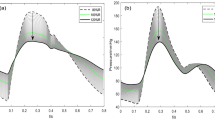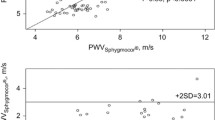Abstract
Purpose
Carotid pulse wave velocity (PWV) is considered as a surrogate marker for carotid stiffness and its assessment is increasingly being used in clinical practice. However, at the moment, its estimation needs specific equipment and a moderate level of technical expertise; moreover, it is based on a mathematical model. The aim of this study was to validate a new system for non-invasive and model-free carotid PWV assessment based on accelerometric sensors by comparison with currently used techniques.
Methods
Accelerometric PWV (accPWV) values were obtained in 97 volunteers free of cardiovascular disease (age 24–85 years) and compared with standard ultrasound-based carotid stiffness parameters, such as carotid PWV (cPWV), relative distension (relD) and distensibility coefficient (DC). Moreover, the comparison between accPWV measurements and carotid-femoral PWV (cfPWV) was performed.
Results
Accelerometric PWV evaluations showed a significant correlation with cPWV measurements (R = 0.67), relD values (R = 0.66) and DC assessments (R = 0.64). These values were also significantly correlated with cfPWV evaluations (R = 0.46). In addition, the first attempt success rate was equal to 76.8 %.
Conclusions
The accelerometric system allows a simple and quick local carotid stiffness evaluation and the values obtained with this system are significantly correlated with known carotid stiffness biomarkers. Therefore, the presented device could provide a concrete opportunity for an easy carotid stiffness evaluation even in clinical practice.









Similar content being viewed by others
Abbreviations
- accPWV:
-
Accelerometric PWV
- BMI:
-
Body mass index
- CI:
-
Confidence interval
- cfPWV:
-
Carotid-femoral PWV
- cPWV:
-
Carotid pulse wave velocity
- DBP:
-
Diastolic blood pressure
- DC:
-
Distensibility coefficient
- DN:
-
Dicrotic notch
- PP:
-
Pulse pressure
- PTT:
-
Pulse transit time
- PWV:
-
Pulse wave velocity
- relD:
-
Relative distension
- RF:
-
Radio-frequency
- SBP:
-
Systolic blood pressure
- SF:
-
Systolic foot
- US:
-
Ultrasound
References
Barenbrock M, Kosh M, Jöster E, Kisters K, Rahn KH, Hausberg M (2002) Reduced arterial distensibility is a predictor of cardiovascular disease in patients after renal transplantation. J Hypertens 20:79–84
Bianchini E, Bozec E, Gemignani V, Faita F, Giannarelli C, Ghiadoni L, Demi M, Boutouyrie P, Laurent S (2010) Assessment of carotid stiffness and intima-media thickness from ultrasound data: comparison between two methods. J Ultrasound Med 29:1169–1175
Bland JM, Altman DG (1986) Statistical methods for assessing agreement between two methods of clinical measurement. Lancet 1:307–310
Brands PJ, Hoeks AP, Willingers J, Willekes C, Reneman RS (1999) An integrated system for the non-invasive assessment of vessel wall and hemodynamic properties of large arteries by means of ultrasound. Eur J Ultrasound 9:257–266
Davies JE, Whinnett ZI, Francis DP, Willson K, Foale RA, Malik IS, Hughes AD, Parker KH, Mayet J (2006) Use of simultaneous pressure and velocity measurements to estimate arterial wave speed at a single site in humans. Am J Physiol Heart Circ Physiol 290(2):H878–H885
Dijk JM, Algra A, van der Graaf Y, Grobbee DE, Bots ML, SMART study group (2005) Carotid stiffness and the risk of new vascular events in patients with manifest cardiovascular disease. The SMART study. Eur Heart J 26:1213–1220
Giannarelli C, Bianchini E, Bruno RM, Magagna A, Landini L, Faita F, Gemignani V, Penno G, Taddei S, Ghiadoni L (2012) Local carotid stiffness and intima-media thickness assessment by a novel ultrasound-based system in essential hypertension. Atherosclerosis 223:372–377
Giannattasio C, Salvi P, Valbusa F, Kearney-Schwartz A, Capra A, Amigoni M, Failla M, Boffi L, Madotto F, Benetos A, Mancia G (2008) Simultaneous measurement of beat-to-beat carotid diameter and pressure changes to assess arterial mechanical properties. Hypertension 52(5):896–902
Hermeling E, Reesink KD, Kornmann LM, Reneman RS, Hoeks AP (2009) The dicrotic notch as alternative time-reference point to measure local pulse wave velocity in the carotid artery by means of ultrasonography. J Hypertens 27(10):2028–2035
Ibrahim el-SH, Johnson KR, Miller AB, Shaffer JM, White RD (2010) Measuring aortic pulse wave velocity using high-field cardiovascular magnetic resonance: comparison of techniques. J Cardiovasc Magn Reson 12(1):26
Laurent S (2006) Arterial stiffness in arterial hypertension. Curr Hypertens Rep 8:179–180
Laurent S, Boutouyrie P, Asmar R, Gautier I, Laloux B, Guize L, Ducimetiere P, Benetos A (2001) Aortic stiffness is an independent predictor of all-cause and cardiovascular mortality in hypertensive patients. Hypertension 37:1236–1241
Laurent S, Katsahian S, Fassot C, Tropeano AI, Gautier I, Laloux B, Boutouyrie P (2003) Aortic stiffness is an independent predictor of fatal stroke in essential hypertension. Stroke 34:1203–1206
Laurent S, Cockcroft J, Van Bortel L, Boutouyrie P, Giannattasio C, Hayoz D, Pannier B, Vlachopoulos C, Wilkinson I, Struijker-Boudier H; European Network for Non-invasive Investigation of Large Arteries (2006) Expert consensus document on arterial stiffness: methodological issues and clinical applications. Eur Heart J 27(21):2588–2605
Mancia G, De Backer G, Dominiczak A, Cifkova R, Fgard R, Germano G, Grassi G, Heagerty AM, Kjeldsen SE, Laurent S, Narkiewicz K, Ruilope L, Rynkiewicz A, Schmieder RE, Boudier HA, Zanchetti A, ESH-ESC Task Force on the Management of Arterial Hypertension (2007) 2007 ESH-ESC practice guidelines for the management of arterial hypertension: ESH-ESC Task Force on the Management of Arterial Hypertension. J Hypertens 25:1751–1762
Mattace-Raso FU, van der Cammen TJ, Hofman A, van Popele NM, Bos ML, Schalekamp MA, Asmar R, Reneman RS, Hoeks AP, Breteler MM, Wittemen JC (2006) Arterial stiffness and risk of coronary heart disease and stroke: the Rotterdam study. Circulation 113:657–663
Németh ZK, Studinger P, Kiss I, Othmane Tel H, Nemcsik J, Fekete BC, Deàk G, Egresits J, Szathmàri M, Tislér A (2011) The method of distance measurement and torso length influences the relationship of pulse wave velocity to cardiovascular mortality. Am J Hypertens 24(2):155–161
Oliver JJ, Webb DJ (2003) Non invasive assessment of arterial stiffness and risk of atherosclerotic events. Arterioscler Thromb Vasc Biol 23:554–556
O’Rourke MF, Staessen JA, Vlachopoulos C, Duprez D, Plante GE (2002) Clinical applications of arterial stiffness: definitions and reference values. Am J Hypertens 15:426–444
Paini A, Boutouyrie P, Calvet D, Tropeano AI, Laloux B, Laurent S (2006) Carotid and aortic stiffness: determinants and discrepancies. Hypertension 47:371–376
Palombo C, Kozakova M, Guraschi N, Bini G, Cesana F, Castoldi G, Stella A, Morizzo C, Giannattasio C (2012) Radiofrequency-based carotid wall tracking: a comparison between two different systems. J Hypertens 30(8):1614–1619
Pan J, Tompkins WJ (1985) A real time QRS detection algorithm. IEEE Trans Biomed Eng 33(3):230–236
Pannier BM, Avolio AP, Hoeks A, Mancia G, Takazawa K (2002) Methods and devices for measuring arterial compliance in humans. AJH 15:743–753
Salvi P, Lio G, Labat C, Ricci E, Pannier B, Benetos A (2004) Validation of a new non-invasive portable tonometer for determining arterial pressure wave and pulse wave velocity: the PulsePen device. J Hypertens 22:2285–2293
Savitzky A, Golay MJE (1964) Smoothing and differentiation of data by simplified least squares procedures. Anal Chem 36(8):1627–1639
Selzer RH, Mack WJ, Lee PL, Kwong-Fu H, Hodis HN (2001) Improved common carotid elasticity and intima-media thickness measurements from computer analysis of sequential ultrasound frames. Atherosclerosis 154(1):185–193
Tamin NSM, Ghani F (2010) Techniques for optimization in time delay estimation from cross correlation function. IJET-IJENS 10(2):49–54
Vlachopoulos C, Aznaouridis K, Stefanidis C (2010) Prediction of cardiovascular events and all-cause mortality with arterial stiffness: a systematic review and meta-analysis. J Am Coll Cardiol 55:1318–1327
Westenberg JJ, van Poelgeest EP, Steendijk P, Grotenhuis HB, Jukema JW, de Roos A (2012) Bramwell–Hill modeling for local aortic pulse wave velocity estimation: a validation study with velocity-encoded cardiovascular magnetic resonance and invasive pressure assessment. J Cardiovasc Magn Reson 14:2
Whittaker ET, Robinson G (1967) The trapezoidal and parabolic rules. In: The calculus of observations: a treatise on numerical mathematics, 4th edn. Dover, New York, pp 156–158
Wilkinson IB, McEniery CM, Schillaci G, Boutouyrie P, Segers P, Donald A, Chowienczyk PJ, On behalf of the ARTERY Society (2010) ARTERY Society guidelines for validation of non-invasive hemodynamic measurement devices: Part 1, arterial pulse wave velocity. Artery Research 4:34–40
Conflict of interest
Elisabetta Bianchini, Francesco Faita, Vincenzo Gemignani and Lorenzo Ghiadoni are co-founders and councillors of QUIPU s.r.l., Pisa, ITALY, a spin-off company of the National Research Council and the University of Pisa.
Author information
Authors and Affiliations
Corresponding author
Additional information
Communicated by Guido Ferretti.
Rights and permissions
About this article
Cite this article
Di Lascio, N., Bruno, R.M., Stea, F. et al. Non-invasive assessment of carotid PWV via accelerometric sensors: validation of a new device and comparison with established techniques. Eur J Appl Physiol 114, 1503–1512 (2014). https://doi.org/10.1007/s00421-014-2881-2
Received:
Accepted:
Published:
Issue Date:
DOI: https://doi.org/10.1007/s00421-014-2881-2




